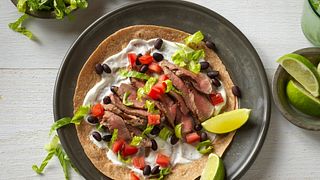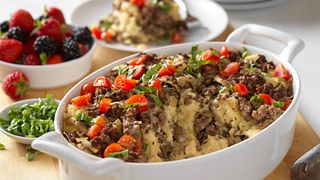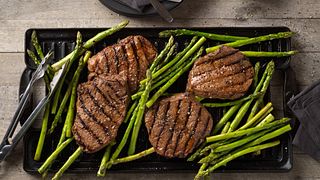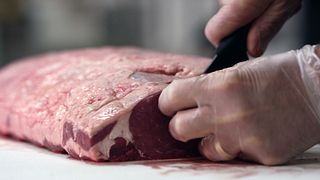Beef Means Business: Interview with Chef Joe Sasto
Chef Joe Sasto’s work at San Francisco’s Quince and Lazy Bear led to both restaurants’ rise in Michelin stars. Known for his handmade pastas, and signature mustache, Joe was a finalist on Bravo’s Top Chef Season 15. He returns to Top Chef on Thursday, March 19th at 10/9c as an All Star competitor against other Top Chef finalists, front runners and fan favorites. The Beef. It’s What’s For Dinner. team recently had an opportunity to ask him about how he has worked with various beef cuts throughout his career, pairing beef cuts with pasta, and even preparing Rocky Mountain oysters.
Why would you recommend putting a beef item on the menu?
It's a really approachable protein across the board that I think a lot of people can relate to and draw nostalgia from.
How do you harness the versatility of beef – from affordable cuts like Ground Beef up to Ribeyes and Filet Mignons?
Approaching each cut of beef as if it deserves the same level of respect and care, whether you're using Ground Beef or something like a Tenderloin Steak, is important. Every cut deserves the same level of attention and love.
How do you innovate with beef?
I innovate by drawing on nostalgia and utilizing different cuts that may be underrepresented. I think about new ways to prepare them and show them to people in a way they haven't had them before.
When you’ve been in charge of menu development, do you adjust the beef you menu seasonally? If so, how?
I pay attention to the kind of weather outside. So, in the wintertime, I like to make rich, hearty kinds of stew to go with pastas, whereas in the summer I prefer a nice cold beef tartare.
You’re known for your pastas… which beef cuts work best with pasta?
I like pasta because it acts as a vehicle for many different cuts of beef: you can use really muscular cuts, like Chuck Roast, to make ragouts or sugos that go well with pasta, or use the fatty or leaner cuts like Ribeye Steak or a Filet Mignon, respectively, as a filling. So, pasta is really a versatile, universal vehicle for all things.
What’s your favorite steak cut and how do you like to prepare it?
I like the Ribeye Cap. I feel like you get the best of both worlds from the fattiness of the Ribeye and the flavor of the cut. I like it either simply butter roasted, basted with garlic and thyme or lightly kissed over binchotan charcoal.
How have beef dishes contributed towards helping restaurants like Quince and Lazy Bear gain Michelin stars?
I think the process of dry aging really makes a big difference and sets a lot of high end places apart because most beef isn’t dry aged or can't be dry aged at home. It's a labor-intensive process. By removing the moisture and letting that enzymatic activity break down the inner workings of the beef, you end up with a more flavorful and tender cut.On Top Chef you won a quickfire challenge preparing Rocky Mountain oysters… you were praised for “treating them with respect.” What do you think was key to working with them?
I think it was approaching them and elevating them like it any other expensive cut of meat and not just treating it differently because it was an unusual cut.
What are other challenging cuts to work with that are worth it if properly executed?
I think Chuck Roast is one of those cuts because it's economical and often only thought of as something you can make pot roasts with, when really there are a lot of different uses.
You started Top Chef by preparing a beef tartare. What are the pro-tips to a successful beef tartare?
I think the most easily overlooked aspect of tartare, which is easiest to accomplish, is keeping things ice cold. Use an ice bowl below the bowl you're mixing your tartare in so your beef is as cold as possible when you serve it. Keeping it cold until the last minute makes all the difference.




